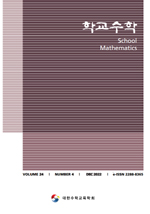학술논문
귀납적 추론의 과정 분석
이용수 4
- 영문명
- Analysis of Inductive Reasoning Process
- 발행기관
- 대한수학교육학회
- 저자명
- 이성근 류희수
- 간행물 정보
- 『학교수학』제14권 제1호, 85~107쪽, 전체 23쪽
- 주제분류
- 사회과학 > 교육학
- 파일형태
- 발행일자
- 2012.03.31
5,560원
구매일시로부터 72시간 이내에 다운로드 가능합니다.
이 학술논문 정보는 (주)교보문고와 각 발행기관 사이에 저작물 이용 계약이 체결된 것으로, 교보문고를 통해 제공되고 있습니다.

국문 초록
본 연구에서는 문제해결에서 귀납적 추론의 과정을 분석하여 귀납적 추론의 단계를 0단계 문제 이해, 1단계 규칙성 인식, 2단계 자료 수집․실험․관찰, 3단계 추측(3-1단계)과 검증(3-2단계), 4단계 발전의 총 5단계로, 귀납적 추론의 흐름은 0단계에서 4단계로의 순차적인 흐름을 포함하여 자신이 찾은 규칙이나 추측에 대하여 반례를 발견하였을 때 대처하는 방식에 따라 다양하게 설정하였다. 또한 초등학교 6학년 학생 4명에 대한 사례 연구를 통하여 연구자가 설정한 귀납적 추론 단계와 흐름의 적절성을 확인하였고 귀납적 추론의 지도를 위한 시사점을 도출하였다.
영문 초록
Problem solving is important in school mathematics as the means and end of mathematics education. In elementary school, inductive reasoning is closely linked to problem solving. The purpose of this study was to examine ways of improving problem solving ability through analysis of inductive reasoning process. After the process of inductive reasoning in problem solving was analyzed, five different stages of inductive reasoning were selected. It's assumed that the flow of inductive reasoning would begin with stage 0 and then go on to the higher stages step by step, and diverse sorts of additional inductive reasoning flow were selected depending on what students would do in case of finding counter examples to a regulation found by them or to their inference. And then a case study was implemented after four elementary school students who were in their sixth grade were selected in order to check the appropriateness of the stages and flows of inductive reasoning selected in this study, and how to teach inductive reasoning and what to teach to improve problem solving ability in terms of questioning and advising, the creation of student-centered class culture and representation were discussed to map out lesson plans. The conclusion of the study and the implications of the conclusion were as follows:First, a change of teacher roles is required in problem-solving education. Teachers should provide students with a wide variety of problem-solving strategies, serve as facilitators of their thinking and give many chances for them ide splore the given problems on their own. And they should be careful entegieto take considerations on the level of each student's understanding, the changes of their thinking during problem-solving process and their response. Second, elementary schools also should provide more intensive education on justification, and one of the best teaching methods will be by taking generic examples. Third, a student-centered classroom should be created to further the class participation of students and encourage them to explore without any restrictions. Fourth, inductive reasoning should be viewed as a crucial means to boost mathematical creativity.
목차
Ⅰ. 서론
Ⅱ. 이론적 배경
Ⅲ. 귀납적 추론의 과정 분석
Ⅳ. 연구 방법
Ⅴ. 연구 결과
Ⅴ. 결론 및 시사점
참고문헌
키워드
해당간행물 수록 논문
- 수학교육의 교수-학습 참평가 모형 및 예시 도구 개발
- 초등 수학 교과서의 학습 활동유형에 대한 분석
- Exploring Teachers' Knowledge of Partitive Fraction Division
- 수학교과와 융복합교육
- 귀납적 추론의 과정 분석
- 수학 교과교실의 발전 방향 제안
- The Construction of Children's Partitioning Strategy on the Equal Sharing Situation
- 초등수학 교과서의 분수 곱셈 알고리즘 구성 활동 분석
- 문제 해결 과정에서 나타나는 수학적 시각화의 구성 요소 및 활용에 관한 분석
참고문헌
관련논문
사회과학 > 교육학분야 BEST
더보기사회과학 > 교육학분야 NEW
- [토론문] 한국 장학재단 학자금 대출과 국가장학금 수혜에 따른 대학생의 학업성취도, 대학생활 및 삶의 질 분석
- [발표 3-4] 한국 장학재단 학자금 대출과 국가장학금 수혜에 따른 대학생의 학업성취도, 대학생활 및 삶의 질 분석
- [토론문] 중고등학생의 참여자치역량 강화를 위한 서울교육정책 현황 및 개선 방안
최근 이용한 논문
교보eBook 첫 방문을 환영 합니다!

신규가입 혜택 지급이 완료 되었습니다.
바로 사용 가능한 교보e캐시 1,000원 (유효기간 7일)
지금 바로 교보eBook의 다양한 콘텐츠를 이용해 보세요!



